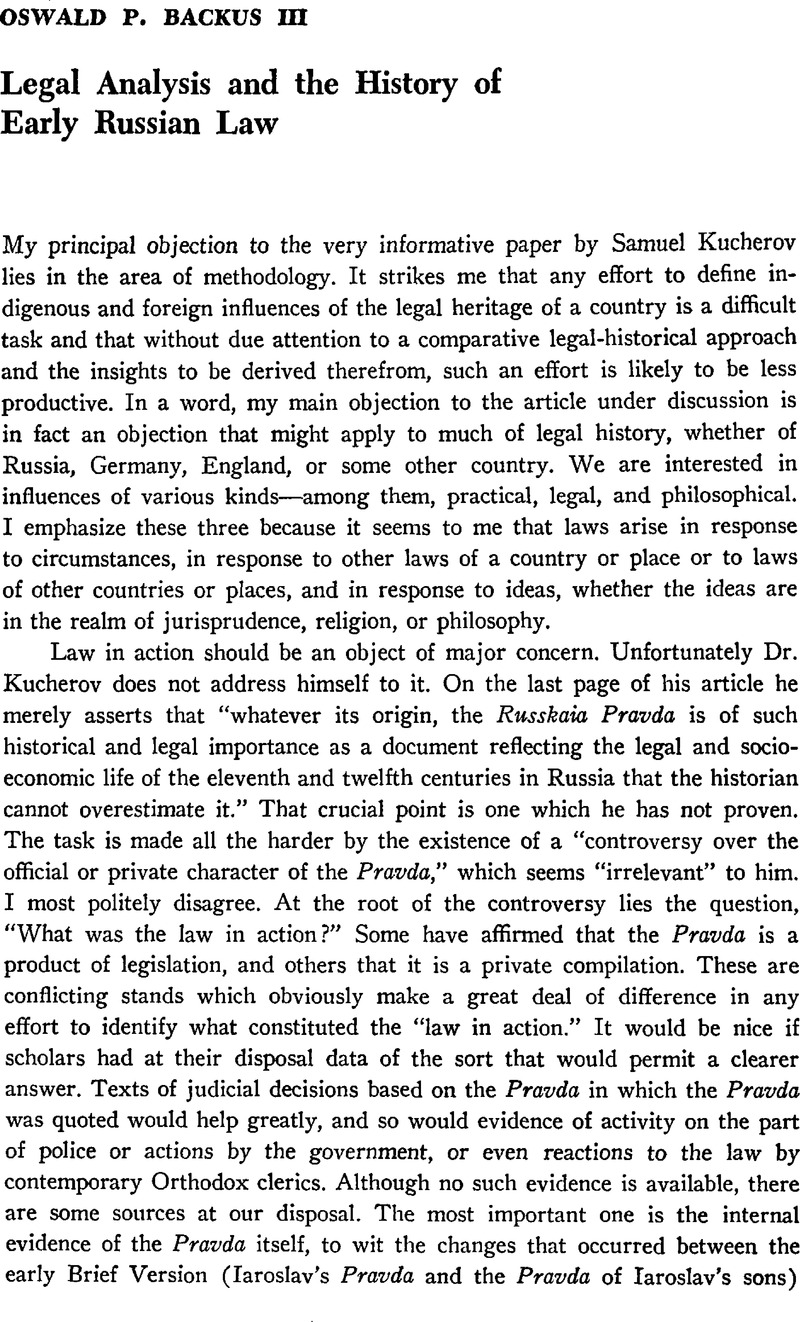No CrossRef data available.
Published online by Cambridge University Press: 27 January 2017

1. All citations are from Vernadsky, George, Medieval Russian Laws (New York, 1947)Google Scholar.
2. Vladimirsky-Budanov, M. F., Obzor istorii russkago prava, 7th ed. (Petrograd and Kiev, 1917), pp. 86–89.Google Scholar In appendix K (p. 292) Vladimirsky-Budanov reaffirmed his position. He asserted, in effect, that individual psychological differences only modify details: “the principal, basic norms remain the same throughout mankind.“
3. Plucknett, T. F. T., A Concise History of the Common Law, 5th ed. (Boston, 1956), p. 21 Google Scholar notes a simultaneous growth of local government.
4. Bracton, Henry de, De legibus et consuetudinibus Angliae, 1st printed ed. (London, 1569).Google Scholar
5. One of the most important local Lithuanian laws is the Samogitian Privilege of 1492, published in A. T. Działyński, ed., Zbiór Praw Litewskich od roku 1389 do roku 1529: Tudzież rozprawy Sejmowe o tychże prawach od roku 1544 do roku 1563 (Poznań, 1841), pp. 68-71. Of local Polish laws the Mazovian Code of 1540 is the most important.
6. The First Lithuanian Statute has been published, among other places, in K. I. Iablonskis [Jablonskis], ed., Statut Velikogo kniazhestva Litovskogo (Minsk, 1960).Google Scholar Didžiosios Lietuvos Kunigaikštijos 1529 metu, ed. A. Plateris, trans. J. Deveikė (Chicago, 1971), is a Lithuanian translation with an enlarged reproduction of Iablonskis's text. The collection of 1553 was followed by a systematic collection in 1570. Bardach, Juliusz, ed., Historia państiwa i prawa Polski, vol. 2, 3rd ed. (Warsaw, 1968), p. 22.Google Scholar
7. Ibid., p. 99.
8. A text of the Code of the Northern Dvina Land may be found in Grekov, B. D. et al., eds., Sudebniki XV-XVI vekov (Moscow and Leningrad, 1952), pp. 366–414.Google Scholar A. I. Kopanev, the author of the commentary, tends toward the view that the code was in force (pp. 417-23). Vladimirsky-Budanov, Obzor, appendix M, pp. 301-3, indicates various arguments pro and con and concludes that, from the available evidence, “no conclusion follows either for or against the recognition of this monument as law.”
9. For example, Provinzialrecht des Ostseegouvernements, 2 pts. (St. Petersburg, 1845), Fortsetzung des Provinzialrechts des Ostseegouvernements bis zumindesten Januar 1853 (n.p., n.d.), Provinzialrecht des Ostseegouvernements, 3rd pt. (St. Petersburg, 1864). Examples of codes of constituent republics of the USSR are the following codes of the Lithuanian Soviet Socialist Republic: Civil Code of the LSSR (Vilnius, 1964), Code of Civil Procedure of the LSSR (Vilnius, 1964), Criminal Code of the LSSR (Vilnius, 1962), Code of Criminal Procedure of the LSSR (Vilnius, 1962).
10. Hafström, Gerhard, Ledung och Marklandsindelning (Uppsala, 1949), pp 74–81 83-86.Google Scholar
11. Orfield, L. B., The Growth of Scandinavian Law (Philadelphia, 1953), pp. 253–54 Google Scholar, indicates that “the oldest law text is the Vestgöta-lag” from the early thirteenth century. It was followed by other law books for various provinces. At the same time all-Swedish law codes developed from the thirteenth through the fourteenth century.
12. Stender-Petersen, Adolf, Die Varägersage als Quelle der altrussischen Chronik (Aarhus and Leipzig, 1934)Google Scholar = Acta Jutlandica, vol. 6, no. 1 (Copenhagen, 1934).
13. For a discussion of purpose see Fuller, L. L., The Morality of Law (New Haven and London, 1964), pp. 145-51.Google Scholar
14. See Backus, O. P., “Folklore and History of Old Russia,” Folkways, 3 (1964): 58–73.Google Scholar
15. For a discussion of Savigny’s handling of customary law see Friedrich, Carl J., The Philosophy of Law in Historical Perspective, 2nd ed. (Chicago, 1963), pp. 137–40.Google Scholar